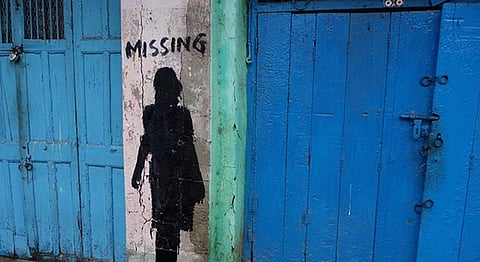
- HOMEGROWN WORLD
- #HGCREATORS
- #HGEXPLORE
- #HGVOICES
- #HGSHOP
- CAREERS
- ABOUT US
- CONTACT US

Human trafficking is a billion dollar industry which keeps growing across the world. Young girls and women are commodified, bought and sold on a global platform; entirely comparable to a form of modern-day slavery. In India alone, 1.2 million children are estimated to be working in the sex industry, and tens of thousands of girls go missing every year. Many of them are abducted or lured away from their homes under false pretenses by traffickers and then sold to brothels, kept as sex slaves and forced into prostitution. The average and desired age of the girls is said to be as young as between 9-15 years old. In a country where there is no specific law focusing on missing children, almost 40% of them are never found; yet the issue is brushed aside and spoken about behind closed doors.
Kolkata based photographer and installation artist, Leena Kejriwal started M.I.S.S.I.N.G, to draw attention to this dark reality, an ode to the hundreds of vulnerable young girls from every corner of the country, if you will. The installation comprises of a series of large silhouettes of young girls made of metal and painted black, “they seem like sharp, black holes cut out of the sky into which millions of girls disappear from the face of the earth,” as described on the official web page. Her thought-provoking installations have been showcased in multiple cities across the globe right from Kolkata and Delhi, to Tehran, Berlin and Weimer.
Complementing the structures is the Missing App, which can be used by smartphone users to dive into the silhouettes ‘darkness’ in which these girls are thrown, and learn more about where they’re coming from and what they’re dealt with. Holding the App open in front of an installation piece, you are taken to an augmented reality animation. The animation ends on a screen where listed are current petitions in circulation that can be signed to help in encouraging the lawmakers to develop and manipulate the existing laws to better aid and service these children. You are also presented with a list of NGOs in the area, which can be contacted for further information about how you can help.
In an effort to engage the interest and active participation of the public, Kejriwal also launched a crowd-funding campaign to help fund the project, so it could be exhibited in various locations in order to create more awareness; it was hugely successful. The funds have gone towards developing the App, creating the installation structures that have changed and modeified over time. In an interview with The Goodwill Project she says, “I have been working on the issue of sexual trafficking and commodification of sex for a while now. When I started out, the large installations used layers of vinyl, paper, prints, lights and rope and succeeded in generating a very graphic experience. But, it was too complicated for everyone to understand. So I decided to simplify the language.”
The project also includes the stencil project, where students and artists work with survivors of sex trafficking, now in NGOs, to put the M.I.S.S.I.N.G silhouettes on city walls, and the stencils have even found there way into villages. With several cases of parents selling their girl-child in exchange for a few rupees, girls sold to repay debts, young girls being kidnapped and then sold in another place across the country to pimps and traffickers; it’s in these villages where this issue may need to be addressed the most. The project premiered at the India Art Fair, in 2014, where it was greatly received and the crowd-funding campaign on Wishberry reached its goal too. However, Kejriwal herself hasn’t reached her goal; girls still go missing on a daily basis, and most of them are never heard from again nor found. It’s a sad reality but one that is forced upon a growing number of Indian girls. There have been several successful rescues and legal cases against people involved in trafficking, but it’s still just the tip of the iceberg. The government needs to be actively involved and take bigger steps to ensure the safety of our country’s girls, look for those who are lost in this inhumane trade and make sure the perpetrators are brought to justice.
If you would like to get involved in the fight against human trafficking, donate or volunteer, you can visit the websites of the following NGOs that are doing great work for the betterment of rescued women and children; Prajwala, Prerana, Rescue Foundation, Bombay Teen Challenge, Apne Aap and Stop India, to name a few.
Written by Sara Hussain
